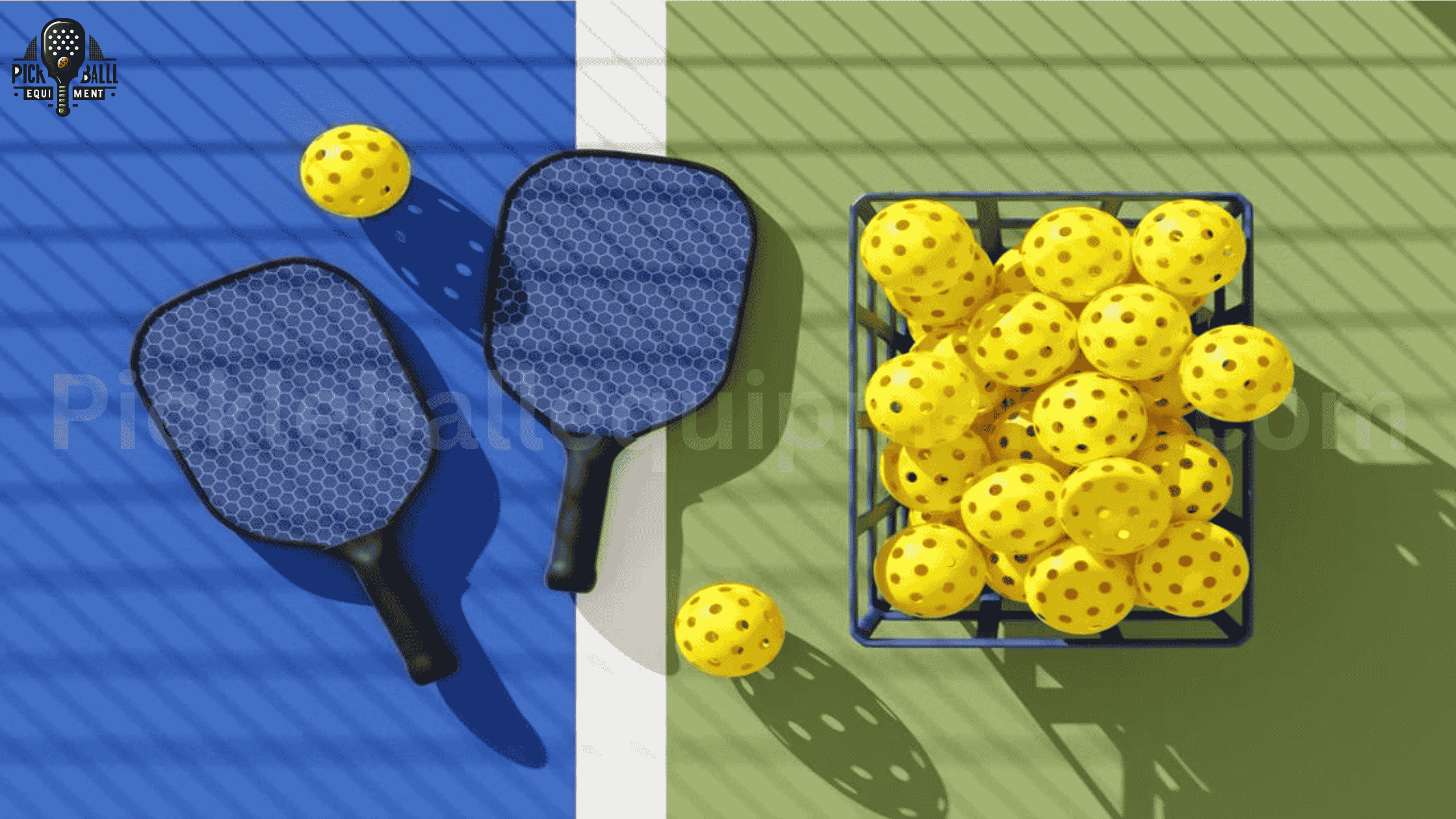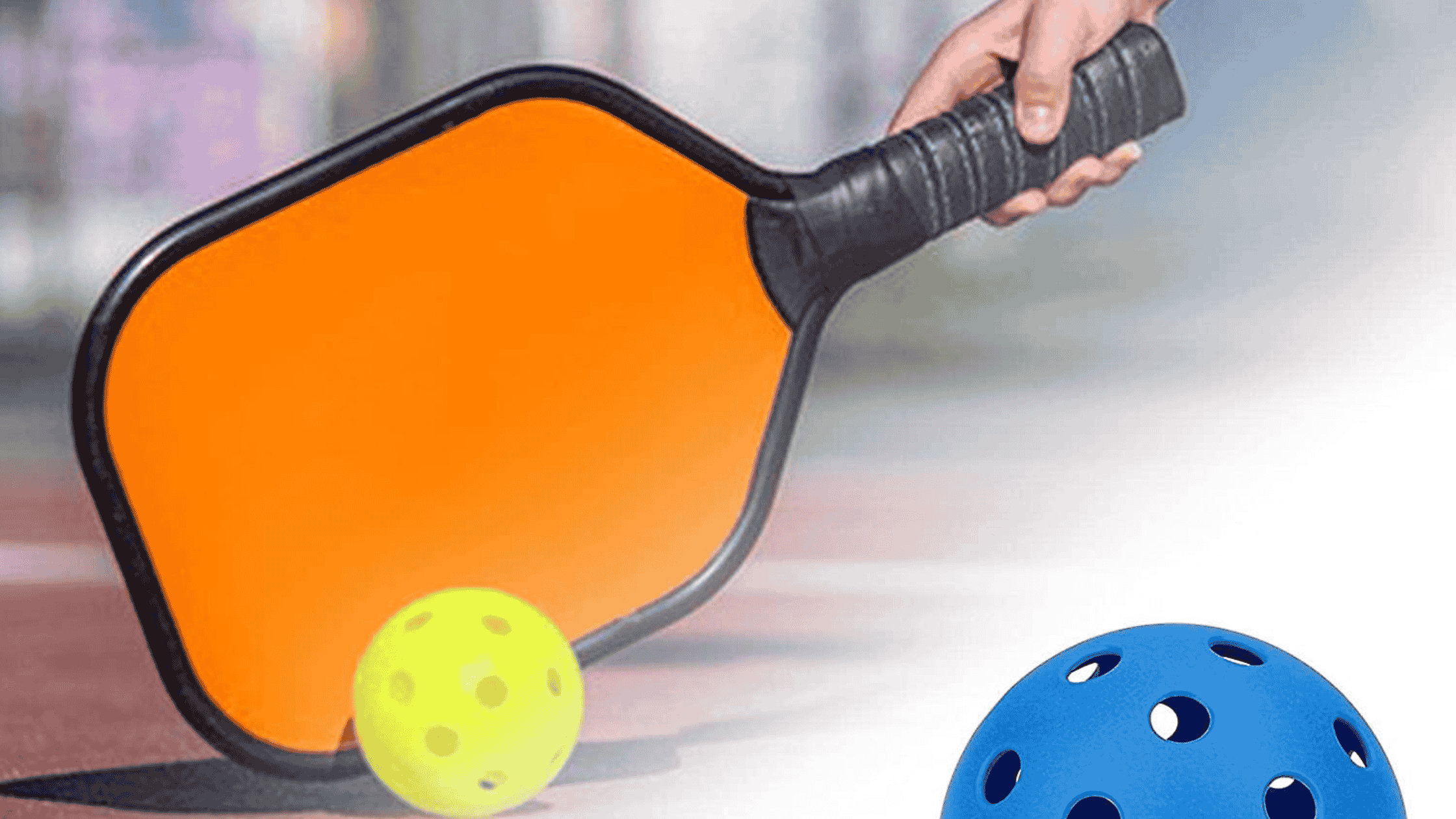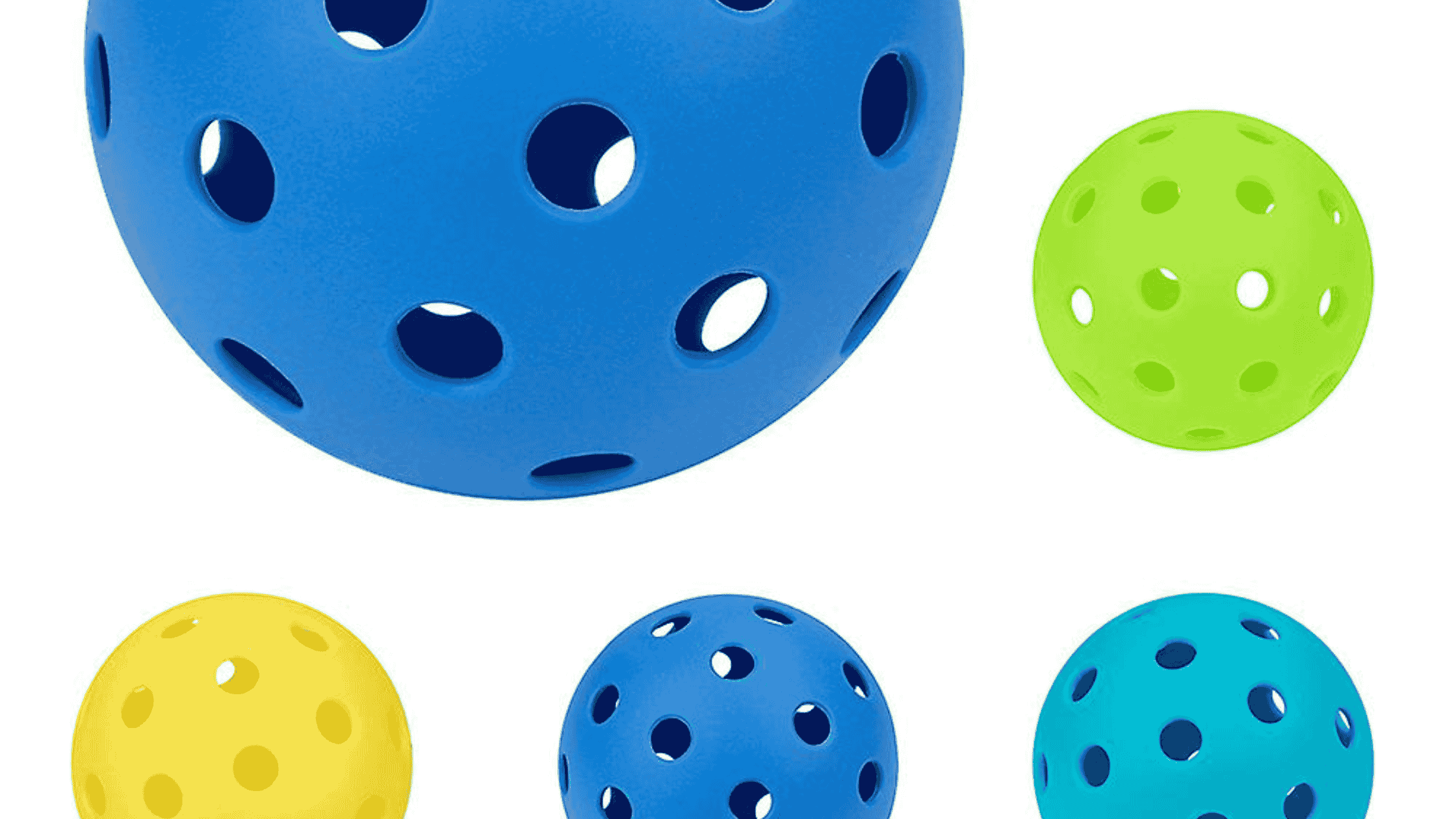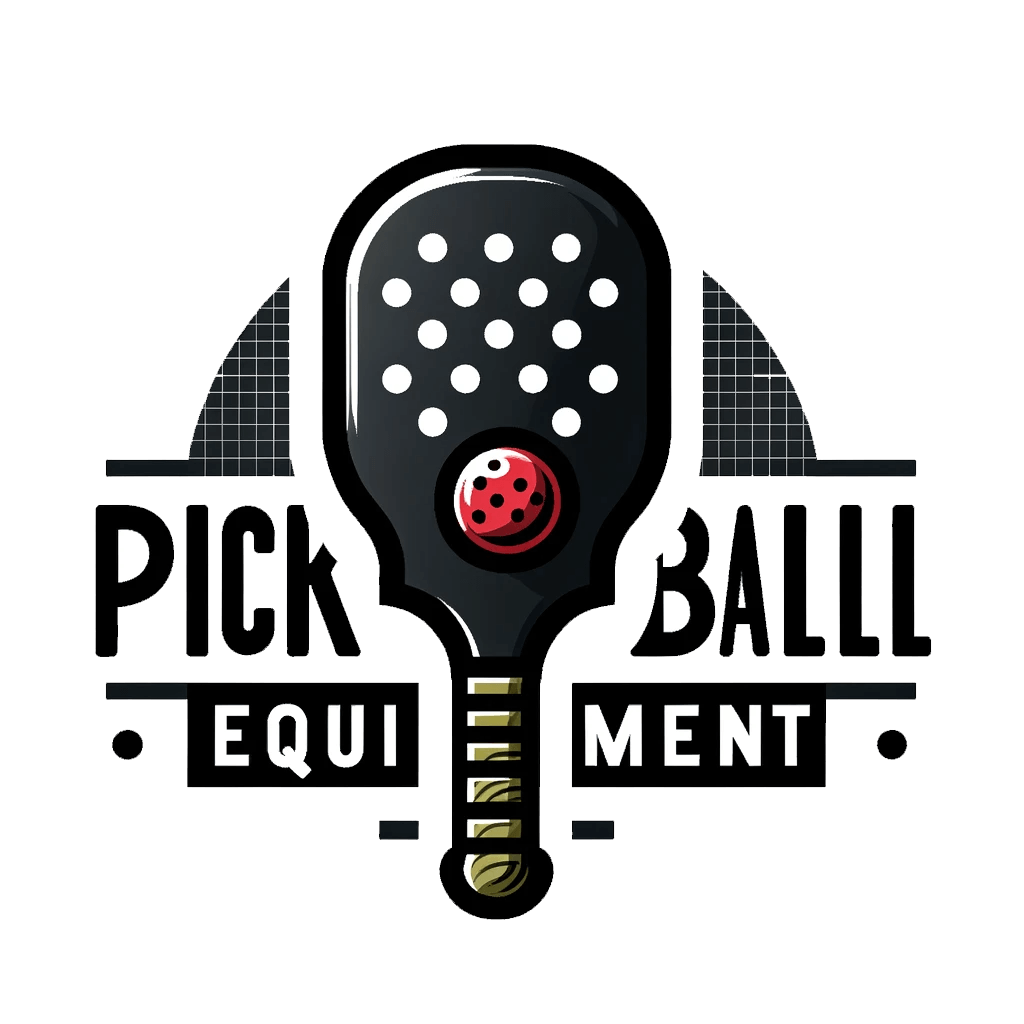How often do you need to replace pickleball balls? Understanding when to replace tennis balls is essential for any avid player, especially those at the pro level. Here’s a pro tip: regularly check your tennis balls for any visible holes. The longevity of these tennis balls can vary depending on several factors, such as the playing surface, frequency of use, and brand quality. This is true for both pickleball balls and tennis balls. The stiffness of the rubber used in the product also plays a role in determining its lifespan.
Pickleball balls, like tennis balls, have a limited lifespan due to wear and tear from gameplay. Over time, these balls can develop soft spots or holes. Over time, wiffle balls, tennis balls, and outdoor balls can lose their bounce, become less responsive, or develop noticeable holes in the ground. Replacing the product, such as a ball machine, at the right time helps you play consistently and avoid game disadvantages. The spring inside the ball machine is crucial for its performance, so it’s important to monitor and replace it when necessary. Additionally, regularly checking for any holes in the ball machine is essential to ensuring optimal functionality.
In the following sections, we will discuss the factors that affect the lifespan of tennis balls and pickleball balls in more detail. These factors include the quality of the product, the impact of spring weather conditions, and the presence of holes or damage. We’ll also provide tips on how to extend the life of your energy product and highlight some key differences between various brands.
Additionally, we’ll include links to resources for finding the best grip products. If you want to know how often to replace your pickleball balls for the best game performance, keep reading! This product is essential for maintaining energy during gameplay. Additionally, it’s important to consider the quality of the shoes you wear while playing pickleball.
Key Takeaways
How Often to Replace Pickleball Balls

The Lifespan of Pickleball Balls
Average Lifespan Expectations
Players who want to perform at their best should know how long pickleball balls typically last. This information is especially important when considering the durability of the product and the energy required to play. Additionally, the type of shoes worn can also impact performance, as shoes with proper stiffness provide better stability and support during gameplay. The lifespan of a pickleball ball, a product similar to wiffle balls, can be affected by factors such as usage frequency, playing surface, and storage conditions.
These factors can impact the stiffness and durability of the polymer chains within the ball. Outdoor pickleball balls, made from polymer chains, are designed specifically for outdoor play. These balls have increased stiffness and durability compared to indoor or wiffle balls.
It’s important to consider their stiffness and overall condition. Over time, outdoor pickleballs may lose their original stiffness or become significantly worn out due to repeated use. This can happen because the polymer chains in the product break down. Once the tennis ball or wiffle ball becomes worn out and loses its bounce and consistency on the court, players often choose to replace them with new ones.
Impact of Usage Frequency
The frequency at which you play pickleball has a direct impact on the lifespan of your balls. The stiffness of the balls is affected by the chains. Regular usage leads to wear and tear, gradually affecting the durability and stiffness of the balls. The chains connected to the balls can also contribute to this deterioration. Players who play a lot may need to buy new pickleballs more often than those who play less due to the wear and tear caused by constant use. The continuous use of pickleballs can result in the deterioration of the chains, necessitating frequent replacements.
Playing a lot or competing can make pickleballs wear out faster, especially if they are used frequently on chains. The harder wiffle balls and tennis balls are hit and the more aggressive the gameplay style, the quicker they may show signs of deterioration. Players who play intense matches need to replace their pickleballs more often than casual players.
Weather and Environmental Effects
The weather and environment affect how long your pickleball balls will last. Outdoor elements such as temperature, humidity, wind, and even exposure to sunlight can affect ball longevity.
Extreme weather conditions, like excessive heat or cold, can cause material degradation over time. Hot weather can soften the ball’s outside layer or cause warping. Cold weather can make it brittle and more likely to crack. Humidity can also impact the ball’s bounce and overall performance.
Proper storage of pickleball balls is crucial to maintaining their lifespan. Storing them in a cool, dry place away from direct sunlight can help prevent premature deterioration. It’s advisable to keep them in airtight containers or bags to protect them from moisture and dust when not in use.
Signs of a Worn-Out Pickleball
Pickleball balls, like any sports equipment, eventually wear out over time due to regular use. To keep playing safely and well, it’s important to know when your pickleball needs replacing. Here are some key indicators to watch out for:
Loss of Pickleball Stiffness
One of the first signs that a pickleball ball needs replacement is a loss of stiffness. Over time, the ball’s rubber or plastic material can become less rigid, leading to reduced bounce and playability. When you notice that the ball no longer feels as firm as it used to or doesn’t bounce back with the same vigor, it may be time to consider getting new ones.
Visible Wear and Tear
Another telltale sign of a worn-out pickleball is visible wear and tear on its surface. Look for scuff marks, cracks, or dents on the ball’s exterior. These imperfections can significantly impact both performance and durability. When the surface is damaged, the ball doesn’t interact well with the paddle and court. This affects spin control and accuracy while playing.
Reduced Performance
As pickleball balls age, their overall performance tends to decline. You may start noticing subtle changes in how they respond when struck by a paddle or how they travel through the air. A worn-out pickleball ball might not have the same speed or accuracy as new ones, which can affect how often to replace pickleball balls, your game strategy, and your enjoyment on the court.
Recognizing these signs of wear and tear is crucial for maintaining an optimal playing experience in pickleball. If your balls don’t meet your standards for stiffness, appearance, or performance, replace them.
Indoor vs Outdoor Pickleballs
There are distinct differences between indoor and outdoor options. Outdoor pickleballs are made with a harder plastic material than indoor balls. They are designed for outdoor courts. They are harder, so they can handle rough surfaces and tough outdoor conditions.
Indoor balls are different. They’re made with softer plastic for better control and more spin. The softer surface of indoor balls also helps to minimize noise when playing on indoor courts.
Durability Factors
To know how often you should replace pickleball balls, we need to consider what affects their durability. Different materials and construction techniques can significantly impact how often to replace pickleball balls.
The type of plastic used in manufacturing plays a crucial role in determining durability. Harder plastics tend to be more durable and resistant to wear and tear, making them ideal for outdoor play. Softer plastics used in indoor balls may not last as long but provide better control and spin.
Manufacturing techniques also affect ball durability. High-quality balls are carefully checked during production, so they perform better and last longer.
Longevity Comparisons
To compare how long different pickleball balls last, remember to think about how durable they are. Reviews from users can offer helpful information about how long pickleball balls last.
Some players prefer certain brands or models based on their personal experiences with durability. USA Pickleball-approved tournament balls are famous for being well-made and long-lasting.
It is worth noting that individual playing styles and court conditions can also influence how long a ball lasts. Aggressive players who hit hard shots may experience faster wear on their pickleballs compared to those who have a lighter touch.
Factors Affecting Pickleball Durability

Ball Hardness and Lifespan
The hardness of pickleball balls can significantly impact their lifespan. Softer balls tend to be more prone to wear and tear compared to firmer ones. When deciding which pickleball balls to use, it’s important to know why ball hardness is significant.
Softer balls may wear down faster due to their increased susceptibility to damage during gameplay. When balls are hit against hard surfaces like the paddle or the court, they can get compressed and deformed. Over time, this repeated stress weakens the structure of the ball, leading to a shorter lifespan.
On the other hand, firmer balls are generally more durable and long-lasting. They are designed to withstand intense play without losing their shape or performance quality. The natural stiffness helps to resist compression and deformation from strong shots or impacts.
It is important to think about how hard the ball is when you replace pickleball balls. This helps keep the gameplay consistent. When softer balls get old, they don’t bounce well and affect accuracy and enjoyment in games. By replacing them with appropriately firm balls, players can ensure optimal performance on the court.
Material and Manufacturing Quality
The quality of pickleball balls and how they are made affect how long they last. USA Pickleball’s balls are well-known for their high quality. They are made with top-notch materials and undergo careful manufacturing.
Pickleball balls last longer when made with good materials that bounce back and resist damage. Outdoor pickleballs designed for harsh conditions often use strong, durable plastics. These materials provide excellent durability while maintaining consistent performance characteristics.
Manufacturing processes also influence the durability of pickleball balls. Reputable brands employ advanced techniques that ensure precise construction and reliable performance. These methods make strong seams that withstand tough play, reducing the chance of splitting or cracking early.
To choose durable pickleball balls, look for signs of high-quality materials and manufacturing. Look for well-known brands with a reputation for producing high-quality products. Look for certifications or endorsements from pickleball organizations. They show high-quality materials and strict manufacturing standards.
Official Requirements and User Experience
USAPA Standards for Balls
The USAPA, or the USA Pickleball Association, has set standards for pickleball balls. These standards provide guidance on when to replace pickleball balls based on their usage and performance. Adhering to these standards is crucial to maintaining the integrity of the game and ensuring a fair playing experience.
User Observations on Ball Performance
In addition to official rules, user experience also affects when to replace pickleball balls. Players have observed that various factors can affect the lifespan of pickleball balls. These factors include the type of game being played, the playing surface, weather conditions, and many others.
Hearing from players about how pickleball balls work as time goes on can give us useful information. Users have reported variations in performance among different brands or types of balls. Some brands may offer better durability and longevity compared to others.
Understanding how player observations inform replacement decisions is essential. When a ball starts losing its pop or becomes significantly damaged, it may be time for a replacement. Players can use feedback to determine when to retire old balls and introduce new ones. This helps them identify patterns and trends in ball longevity.
Feedback from users is valuable in assessing ball longevity because it comes from people who play the sport. To choose the right balls, players should check user feedback and official guidelines.
Outdoor pickleball games may need new balls more often than indoor games because of the weather and surface. When you play pickleball outside, the balls get exposed to tough conditions like heat, cold, wind, rain, and rough surfaces.
These factors harm the balls and make them degrade faster as time goes on. Outdoor players often have to replace their pickleball balls more often than indoor players.
In conclusion, both rules and user opinions are important when deciding to get new pickleball balls. By following the USAPA standards, players ensure a fair game and consistent ball performance. Players can use user observations to spot signs of wear and tear and decide whether to replace the ball. Outdoor games need to be replaced more often because of weather and surface impact. By considering all these factors, players can ensure they have optimal playing conditions and enjoy the game to the fullest.
Extending the Life of Your Pickleballs
Proper Care and Storage
Proper care and storage are essential for extending the lifespan of your pickleball balls. By following some best practices, you can maximize their durability and save money in the long run.
To begin with, it’s important to clean your pickleball balls regularly. Dirt and debris can accumulate on the surface, affecting their performance. Simply wipe them down with a damp cloth or use a mild soap solution if necessary. Avoid using harsh chemicals or abrasive materials that could damage the balls.
Protecting your pickleball balls from extreme temperatures is crucial. High heat can cause the balls to expand, while cold temperatures can make them brittle. Store them in a cool, dry place away from direct sunlight or freezing conditions.
Consider investing in a ball holder or container specifically designed for pickleballs. This will help prevent them from getting crushed or damaged when not in use. Keeping them separate from other sports equipment will reduce the risk of accidental damage.
Usage Patterns and Ball Rotation
The way you use and rotate your pickleball balls also plays a significant role in their longevity. It’s important to understand how different usage patterns can impact their durability.
If you primarily play outdoors on hard surfaces such as asphalt or concrete, using outdoor pickleballs is recommended. These balls are made for rough play and last longer than indoor balls.
But if you sometimes play indoors on smooth courts, like wood or composite, don’t use outdoor pickleballs. The harder surface of these balls can cause premature wear and tear on indoor courts.
To make your pickleball balls last longer, try rotating them while playing. By regularly switching out worn-out balls with newer ones, you distribute the wear more evenly among all your balls.
Keep track of each ball’s usage by marking them with numbers or colors so that you can rotate them systematically. This way, you’ll ensure that no single ball is subjected to excessive wear and tear.
To make your pickleball balls last longer, learn how usage patterns and ball rotation techniques affect them.
When to Replace Your Pickleballs
Regularly inspecting your pickleball balls for signs of damage or excessive wear is crucial. If you notice any cracks, dents, or loss of bounce, it’s time to replace them. Using damaged balls not only affects gameplay but also increases the risk of injury.
Choosing Durable Pickleball Equipment
Having durable equipment is essential for a satisfying and long-lasting playing experience.
Selecting Long-Lasting Balls
To ensure that your pickleball balls last as long as possible, there are a few factors to consider when making a purchase. First, choose outdoor pickleball balls made for outdoor use. These balls are engineered to provide durability for extended use, even in various weather conditions.
If you want pickleball balls that last long and perform well, choose USA Pickleball-approved ones. These balls undergo rigorous testing to meet specific standards set by the governing body of the sport. By choosing official outdoor pickleballs, you can be confident in their quality and durability.
Friendly polypropylene is more durable than wiffle balls or tennis balls. Balls made from this material for pickleball are strong and can handle intense gameplay without damage or shape loss.
If you want pickleball balls to last a long time, look for features that show how long they will last. Look for reinforced seams or construction methods that enhance durability. Consider the stiffness of the ball; a balance between firmness and bounce is crucial for both performance and longevity.
Equipment Lifespan Considerations
Your pickleball equipment’s lifespan, including the balls, has implications beyond separate parts. The choice of long-lasting balls can also impact other gear, such as paddles and nets.
Consistently using durable outdoor pickleballs can minimize wear on your paddle’s surface. These high-quality balls are less likely to scuff or damage paddle faces than lower-quality options. This extends the lifespan of your paddle, ultimately saving you money in the long run.
Pickleball balls’ durability impacts how much people enjoy playing the sport. Using balls that maintain their shape and bounce over time ensures fair gameplay and accurate shots. It also reduces interruptions during matches due to ball replacements.
Understanding Different Pickleball Balls Types

Pickleball is a popular sport that requires specific equipment, including pickleball balls. There are various pickleball balls for different playing conditions and purposes. These include outdoor pickleball balls, indoor balls, and official pickleball balls.
Outdoor pickleball balls are specifically created to withstand the rigors of outdoor play. They are more durable and can endure various weather conditions, such as heat, cold, wind, and moisture. These balls have a harder composition to ensure they last longer on rough surfaces like asphalt or concrete. Outdoor pickleballs are durable, so players can play for a long time without needing new ones.
Indoor pickleball balls are designed for smoother indoor courts, like wood or synthetic materials. They have a softer composition compared to outdoor balls. The softer material helps reduce noise and prevents damage to the court surface during gameplay. Indoor pickleballs also provide better control and precision due to their reduced bounce.
Official pickleball balls are approved by USA Pickleball, the governing body of the sport in the United States. These balls meet specific standards regarding size, weight, and bounce set by USA Pickleball. Pickleballs approved for games and tournaments are the same, so everyone has a fair chance.
Standard Size and Weight Characteristics
Adhering to standard size and weight characteristics is crucial. Deviations from these standards can affect ball durability and the overall gameplay experience. Using correctly sized and weighted balls is essential for longevity, as it ensures proper performance on the court.
The size of a standard pickleball should measure 2.87 inches in diameter, while its weight should be between 0.78 and 0.935 ounces (22 and 26 grams). Balls that do not meet these specifications may not perform optimally or may wear out quickly during play.
When deciding how often to replace pickleball balls, their size and weight are important factors. If balls are too light or heavy, it may mean they’re worn out and won’t bounce well. To ensure fair gameplay, check pickleball size and weight regularly for replacement.
Material and Color Variations
Pickleball balls are made from various materials, each with its own impact on ball durability. Common materials used include plastic, composite, or a combination of both.
Practical Tips for Pickleball Players
Identifying High-Quality Balls
Players who want durable and consistent pickleball balls must recognize high-quality ones. When assessing ball quality, there are a few indicators to look for. Firstly, check the brand and make sure it is an official pickleball ball designed specifically for the sport. Pickleball balls are made to meet standards, so they work well on the court.
Another important characteristic to consider is the durability of the ball. Look for balls that have been designed to withstand heavy gameplay and frequent use. These balls are made with strong materials and construction to withstand powerful shots and stay intact.
Pay attention to the stiffness of the ball. A good pickleball ball feels firm when squeezed, showing it is resilient and keeps its shape. On the other hand, if a ball feels excessively soft or squishy, it may not last as long and could affect gameplay.
Selecting the Right Ball for Your Play Style
Choosing a pickleball ball that aligns with your play style is essential in determining how long it will last. Different play styles can impact the durability of a ball due to factors such as shot velocity and frequency of play.
If you like aggressive gameplay and strong shots, choose a tough outdoor pickleball ball. Outdoor pickleballs are made to handle tough conditions and intense play, so they last longer.
On the other hand, players who play casually often choose indoor or softer outdoor balls. For example, they might use wiffle balls. Although not as tough as outdoor balls, these still work well for less intense games.
It’s important to note that choosing the right paddle also plays a role in preserving your pickleball balls’ longevity. Paddles with rough or abrasive surfaces can cause more wear and tear on the balls, leading to a shorter lifespan. Therefore, selecting a paddle with a smooth surface can help extend the life of your pickleball balls.
Conclusion
To play well, players must know how long pickleball balls last and how to spot wear. The durability of pickleballs depends on the surface they’re played on, how often they’re used, and how they’re stored. Players can save money and improve their performance by following these tips to extend their equipment’s lifespan.
To maximize the lifespan of pickleball balls, it is recommended to rotate multiple sets during play and store them properly in a cool, dry place. Regularly inspecting the balls for signs of damage or wear will help players determine when it’s time for a replacement. Players can have a better time playing by following these steps and using good pickleball.
I hope you like How Often to Replace Pickleball Balls.
Frequently Asked Questions
Pickleball balls typically last for 10–20 games before they start showing signs of wear. However, the lifespan can vary depending on factors such as playing surface, frequency of use, and ball quality. It’s recommended to inspect your pickleballs regularly and replace them when they become cracked or lose their bounce.
Signs of a worn-out pickleball include cracks, dents, or visible wear on the surface. If the ball loses its bounce and no longer provides a consistent level of playability, it’s time to replace it. Regularly checking for these signs ensures optimal performance during matches.
Yes, there are differences between indoor and outdoor pickleballs. Indoor balls are designed with larger holes and a lighter weight for better control in indoor environments. Outdoor balls are designed with smaller holes and a heavier weight. This helps them withstand wind and last longer on rough surfaces like concrete or asphalt.
Several factors can impact the durability of pickleballs. Factors to consider are the type of playing surface, how often it’s used, where it’s stored, the quality of materials used, and proper care. Taking these factors into consideration helps extend the lifespan of your pickleballs.
To extend the life of your pickleballs, store them in a cool, dry place away from direct sunlight or extreme temperatures. Avoid using them on abrasive surfaces whenever possible. Clean your balls regularly using mild soap and water to remove dirt buildup that can affect their performance over time.
